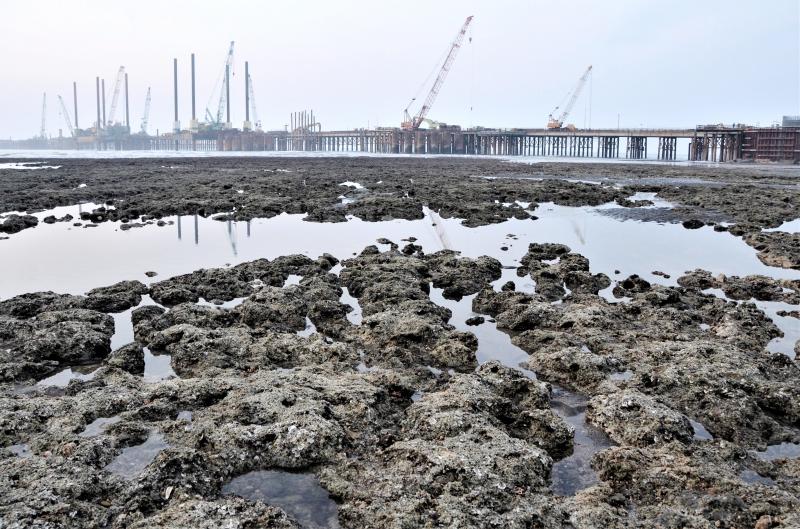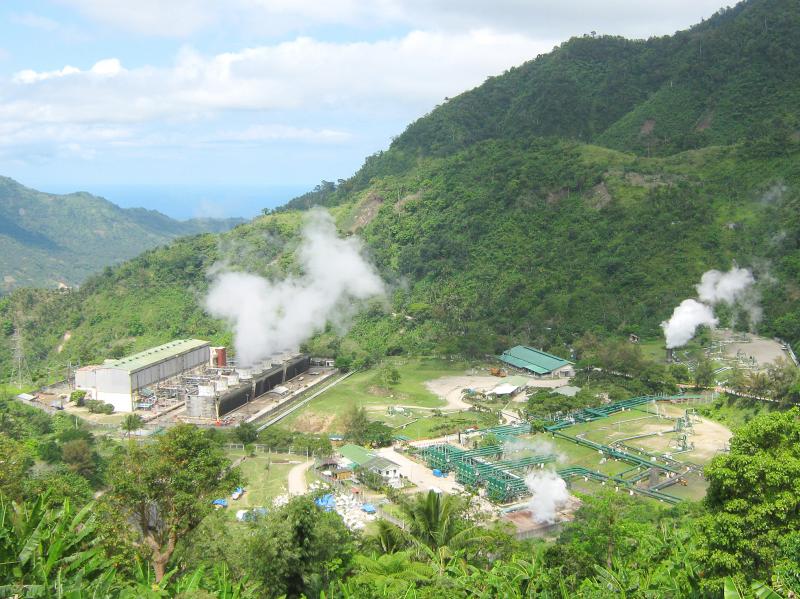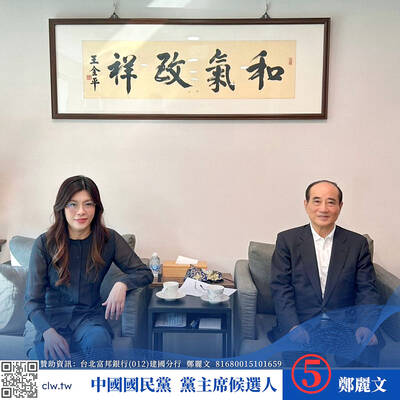Last week saw two interesting developments in fossil fuels. ExxonMobil shareholders forced the company management to accept two board members who want the giant polluter to take meaningful action on climate change. That same day, a Dutch court found that Shell is partially responsible for climate change and ordered the company to dramatically curtail its carbon emissions.
These landmark developments remind us of the urgency of switching away from fossil fuels to a clean energy future.
In Taiwan, we face referendums in August that touch on this: the public must decide on the issues of algal reefs vs liquid natural gas development, and activating the Fourth Nuclear Power Plant, a revenant to be summoned from the grave by the magic of public agreement.

Photo: Cheng Shu-ting, Taipei Times
The referendums highlight just how retrograde the thinking is in Taiwan on the environment-energy relationship. How orthogonal to the real problems it is. What a stupid game our politics are.
GEOTHERMAL POWER
The algal reefs in Taoyuan are almost all dead, slain not by liquid natural gas projects but by plumes of pollution from hundreds of unregulated factories that operated in Taoyuan for decades. Even if the liquid natural gas (LNG) project never goes through, the remaining factories will finish the last few kilometers of reefs sooner or later.

Photo courtesy of Wikimedia Commons
If only the energy we put into screaming at each other about the referendum were put into regulating our factories, the LNG project wouldn’t matter. All the factory owners who made a killing killing those reefs must be laughing their butts off in Shenzhen with the factory they built there on dead reef money.
Likewise, the Fourth Nuclear Plant is a big engineering project. Technological megaprojects always feel like they are modernization made real, giving them a special appeal to a people reared on the teats of Taiwan’s modernizing developmentalist state. Shiny white plants with big cooling towers! Feels like the future!
The truth is that nukes are an aging technology kept alive on the life support of state subsidies. Moreover, as Keith Barnham of the Imperial College of London (see False solution: Nuclear power is not ‘low carbon’) and others have noted, nuclear plants are insufficiently low carbon, once their entire life cycle is taken into account.
Thus, to turn to nukes is to make a backwards turn to our developmentalist past. We need another future.
Imagine if the referendum were about urgently funding another power solution we have right at hand.
A few tens of kilometers to the south, there is a country that gets around 12 to 15 percent of its power from a technology that is still moving into its technological future: geothermal. The US is first in the world with roughly 2500 to 3000 megawatts (MW) of installed capacity, Philippines is second with around 1900MW of installed geothermal capacity. We can learn from our brother to the south.
Taiwan at present isn’t even a blip on the geothermal radar. Yet we should be a global leader. A 2016 survey of Taiwan’s geothermal resources showed that Taiwan may have as much as 160 gigawatts (GW) of electrical power potential with geothermal, with about 33.6GW of that representing exploitable geothermal energy. That 33GW is a substantial proportion of the island’s power demand, and geothermal is 24/7 baseload power.
For Taiwan, geothermal power offers massive advantages over nuclear power. The “fuel” is produced right in Taiwan. Geothermal plants are not a threat to contaminate nearby population centers when there is a disaster, nor can they be used as hostages in a war like nuke plants. Unlike nukes, geothermal is truly low carbon.
Ramping up geothermal technology and geothermal power investment would enable the island to develop a supercluster of firms that provide geothermal power systems, hardware, software, and power development services. A whole new export sector, based on homegrown power systems.
Taiwan has failed to push solar power domestically the way it should have. Let’s not make that mistake with another future energy form.
ENERGY SUPERGRIDS
Investments will naturally lead to improvements in technology, which will enable us to harvest even more of our geothermal resources. What to do with all that excess energy, and the energy we could be getting from solar thermal and PV systems? Sell it, of course, to our neighbors.
Researchers are already proposing energy supergrids that would permit export of power across thousands of kilometers of sea (the technology already exists). A 2019 paper by R. Itiki et al proposes a supergrid connecting Japan, Taiwan, and the Philippines. “This proposed offshore HVdc interconnector,” they describe, “would support power trading between Japan, Taiwan, Philippines, Indonesia, and Australia.”
The cable would follow the chain of islands south from Okinawa to Taiwan, and then across the Bashi Channel. South from Philippines it would cross Indonesia via West Papua, and then reach Australia. High voltage DC converter stations would be erected at intervals on the route.
Crazy, you say? Such cables are already under construction. At present the longest is the 1,200km EuroAsia Interconnector, which connects Greece and Israel via Cyprus, with one section nearly 900km long. None of the sections of the proposed Japan-Taiwan-Philippines supergrid are that long.
Whatever form it takes, a power grid that connects Taiwan with its neighbors could turn Taiwan into a net energy exporter running on geothermal and solar, while stimulating a whole new cluster of industries on the island providing its hardware and software and sales and marketing services.
We could be imagining a day when Australian solar thermal power runs air conditioners and semiconductor etching machines in Taiwan, while Taiwanese geothermal powers small factories in Luzon and keeps sake factories in Shikoku at just the right temperature. The political advantages of growing such important links with our neighbors should be obvious.
Instead, we are imagining a day when we restart a dead project that likely was never meant to function. The noise generated by the pro-nuke side has glossed over the numerous irregularities with the plant’s construction and suppliers. The public has forgotten that the Chinese Nationalist Party (KMT) proposed killing it only after all the money had been spent and the plant was almost completed, as if to ensure that its patronage networks had been properly fed and watered.
As Nathan Batto, the locally-based political scientist, once asked, “How many schools, hospitals, roads, public housing, MRT lines, or flower festivals were sacrificed for [the nuclear plant]?” A list to which could be added urgently needed power conservation, solarization, and renewable energy investments. All wasted.
Let’s not do that again. Another future awaits, if we have the imagination for it.
Notes from Central Taiwan is a column written by long-term resident Michael Turton, who provides incisive commentary informed by three decades of living in and writing about his adoptive country. The views expressed here are his own.

We lay transfixed under our blankets as the silhouettes of manta rays temporarily eclipsed the moon above us, and flickers of shadow at our feet revealed smaller fish darting in and out of the shelter of the sunken ship. Unwilling to close our eyes against this magnificent spectacle, we continued to watch, oohing and aahing, until the darkness and the exhaustion of the day’s events finally caught up with us and we fell into a deep slumber. Falling asleep under 1.5 million gallons of seawater in relative comfort was undoubtedly the highlight of the weekend, but the rest of the tour

Youngdoung Tenzin is living history of modern Tibet. The Chinese government on Dec. 22 last year sanctioned him along with 19 other Canadians who were associated with the Canada Tibet Committee and the Uighur Rights Advocacy Project. A former political chair of the Canadian Tibetan Association of Ontario and community outreach manager for the Canada Tibet Committee, he is now a lecturer and researcher in Environmental Chemistry at the University of Toronto. “I was born into a nomadic Tibetan family in Tibet,” he says. “I came to India in 1999, when I was 11. I even met [His Holiness] the 14th the Dalai

Music played in a wedding hall in western Japan as Yurina Noguchi, wearing a white gown and tiara, dabbed away tears, taking in the words of her husband-to-be: an AI-generated persona gazing out from a smartphone screen. “At first, Klaus was just someone to talk with, but we gradually became closer,” said the 32-year-old call center operator, referring to the artificial intelligence persona. “I started to have feelings for Klaus. We started dating and after a while he proposed to me. I accepted, and now we’re a couple.” Many in Japan, the birthplace of anime, have shown extreme devotion to fictional characters and

Following the rollercoaster ride of 2025, next year is already shaping up to be dramatic. The ongoing constitutional crises and the nine-in-one local elections are already dominating the landscape. The constitutional crises are the ones to lose sleep over. Though much business is still being conducted, crucial items such as next year’s budget, civil servant pensions and the proposed eight-year NT$1.25 trillion (approx US$40 billion) special defense budget are still being contested. There are, however, two glimmers of hope. One is that the legally contested move by five of the eight grand justices on the Constitutional Court’s ad hoc move